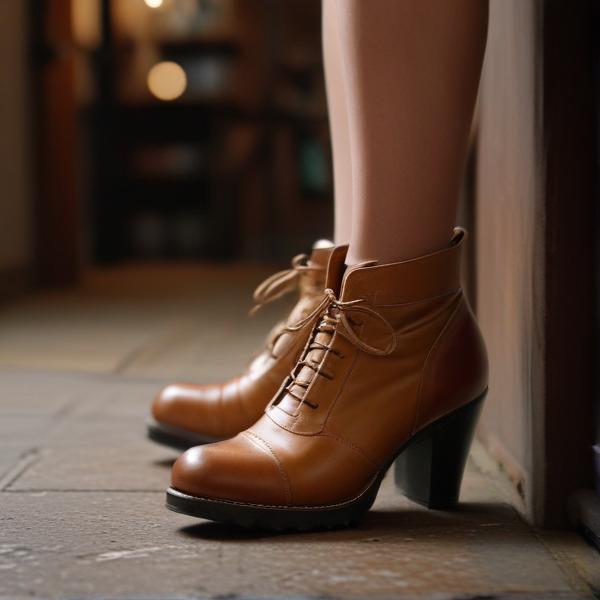基本信息 (Basic Information)
含义与用法 (Meanings & Usage)
中文核心释义 (Core Chinese Meaning): 穿在脚上的物品,用于保护脚或辅助行走,通常指鞋子。
英文核心释义 (Core English Meaning): shoe; footwear worn on the feet for protection or walking.
象形意义 / 为何这么写 (Pictographic Meaning / Writing Rationale)
文言文释义 (Classical Chinese Meaning)
与现代意义相近,指穿在脚上的皮革制品。Similar to modern meaning, referring to footwear made of leather.
深入学习 (In-depth Study)
字源故事 (Origin Story)
字形演变 (Character Evolution)
常用词语和例句 (Common Words & Examples)
鞋子 (shoes (general term for all types of shoes))
这双鞋子很舒服。
Eng: These shoes are very comfortable.
皮鞋 (leather shoes)
他上班时总是穿皮鞋。
Eng: He always wears leather shoes to work.
运动鞋 (sports shoes; sneakers)
我喜欢穿运动鞋跑步。
Eng: I like to wear sneakers for running.
相关成语 (Related Idioms)
削足适履
Meaning: to trim the foot to fit the shoe (to force things to conform, ignoring actual circumstances)
多语言翻译 (核心释义) (Translations (Core Meaning))
- French: chaussure
- German: Schuh
- Spanish: zapato
- Italian: scarpa
- Portuguese: sapato
- Russian: ботинок, обувь
- Arabic: حذاء
- Persian: کفش
- Dutch: schoen
- Polish: but
- Vietnamese: giày
- Ukrainian: взуття, черевик
视频学习资源 (Video Learning Resources)
通过以下链接在热门视频网站搜索 "鞋" 的更多讲解:
Search for more explanations of "鞋" on popular video sites:
- 在 Bilibili.com 搜索 "鞋 字源 说文解字" (Search on Bilibili)
- 在 YouTube.com 搜索 "鞋 character origin etymology" (Search on YouTube)
网络参考 (Web References for "鞋") ()
网络内容摘要 (Web Content Summary):
鞋(xié)是表示“鞋子(shoes)”的常用汉字,指人们穿在脚上的物品,用于保护和装饰。鞋 (xié) is a common Chinese character meaning "shoes," referring to items worn on the feet for protection and decoration.
-
字形与起源:“鞋”由“革”(皮革)和“圭”组成,属于形声字。本义与皮革制成的鞋子有关。早期古人多穿草鞋或皮鞋。Etymology and Structure: “鞋” combines the radical “革” (leather) and the phonetic component “圭”. It is a phono-semantic compound character, originally related to leather shoes. In ancient times, people wore shoes made of grass or leather.
-
常用词语:如“皮鞋(leather shoes)”,“布鞋(cloth shoes)”,“运动鞋(sports shoes)”。Common words: For example, “皮鞋” (leather shoes), “布鞋” (cloth shoes), “运动鞋” (sports shoes).
-
成语和用法:带“鞋”的成语较少,但在实际生活中,“鞋”常用于描述类型、用途,如“鞋码”(shoe size)、“鞋底”(sole)。Idioms and Usage: There are few idioms with “鞋,” but in daily life, it is often used to describe types or parts, such as “鞋码” (shoe size), “鞋底” (sole).
-
易混淆点:“鞋”和“靴(xuē, boots)”不同,后者指较高、包裹脚踝以上的鞋子。Easily confused: "鞋" (shoes) is different from "靴" (xuē, boots), which refers to higher shoes covering above the ankle.
文化趣闻:在中国古代,鞋子常是社会身份的象征,不同材质、样式的鞋子反映身份和时代变化。Cultural Note: In ancient China, shoes often symbolized social status; different materials and styles reflected one's identity and era.
汉字"鞋"的起源、演变过程-汉字字源辞典
汉字字源辞典收录7747条汉字词条,基本涵盖了常见汉字的字源解析,是汉字研究的必备工具。 ... ),表示供践踏的皮革。篆文异体字"鞋 ...
鞋的解释|鞋的意思|汉典"鞋"字的基本解释 - 漢典
鞋. 鞵 xié 〈名〉 (1) (形声。 从革,圭声。皮革鞋的材料。 "圭、鞋" 古音相近。 本义:鞋子) 同本义 [shoes]. 鞵,生革醍也。—— 《说文》 。 字亦作鞋. 古人以草为屦,皮为履,后 唐 马 周 始以麻为之,即鞋也。 —— 《说郛》 引 唐 · 留存 《事始·鞋》 (2) 又如:鞋扇(鞋面);鞋脚(小妾第一次拜见 ...
更多图片 (鞋 More Images) ()
